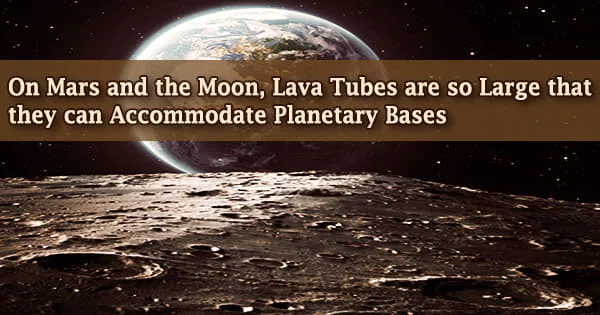The subsurface cavities that lava created underground on Mars and the Moon were studied by researchers from the Universities of Bologna and Padua. These chambers can protect you from cosmic rays.
A publication published in the international journal Earth-Science Reviews provides an overview of lava tubes (pyroducts) on Earth, as well as an estimate of the (larger) size of their lunar and Martian equivalents.
Francesco Sauro and Riccardo Pozzobon, the study’s organizers, worked with the universities of Bologna and Padua. Francesco Sauro is a speleologist and the director of the ESA programs CAVES and PANGAEA. He is also a professor at the University of Bologna’s Department of Biological, Geological, and Environmental Sciences. Riccardo Pozzobon is a planetary geologist at the University of Padua’s Department of Geosciences.
“We can find lava tubes on planet Earth, but also on the subsurface of the Moon and Mars according to the high-resolution pictures of lava tubes’ skylights taken by interplanetary probes. Evidence of lava tubes was often inferred by observing linear cavities and sinuous collapse chains where the galleries cracked,” explains Francesco Sauro.
These collapse chains can be used as subsurface exploration portals or windows. Lava tubes on Mars and the Moon have comparable morphological surface expressions to their terrestrial counterparts. In Hawaii, the Canary Islands, Australia, and Iceland, lava tubes were explored in depth.
“We measured the size and gathered the morphology of lunar and Martian collapse chains (collapsed lava tubes), using digital terrain models (DTMs), which we obtained through satellite stereoscopic images and laser altimetry taken by interplanetary probes,” reminds Riccardo Pozzobon.
“We then compared these data to topographic studies about similar collapse chains on the Earth’s surface and to laser scans of the inside of lava tubes in Lanzarote and the Galapagos. These data allowed to establish a restriction to the relationship between collapse chains and subsurface cavities that are still intact.”
This means that the majority of lava tubes underneath the maria smooth plains are intact. The collapse chains we observed might have been caused by asteroids piercing the tube walls. This is what the collapse chains in Marius Hills seem to suggest. From the latter, we can get access to these huge underground cavities.
Matteo Massironi
Researchers discovered that the tubes on Mars and the moon are 100 and 1,000 times wider than those on Earth, which have a diameter of 10 to 30 meters. The impact of the lower gravity on volcanism explains these extraordinary dimensions (with total volumes exceeding 1 billion of cubic meters on the Moon).
Riccardo Pozzobon adds: ”Tubes as wide as these can be longer than 40 kilometers, making the Moon an extraordinary target for subsurface exploration and potential settlement in the wide protected and stable environments of lava tubes. The latter are so big they can contain Padua’s entire city center.”
“What is most important is that, despite the impressive dimension of the lunar tubes, they remain well within the roof stability threshold because of a lower gravitational attraction,” explains Matteo Massironi, who is professor of Structural and Planetary Geology at the Department of Geosciences of the University of Padua.
“This means that the majority of lava tubes underneath the maria smooth plains are intact. The collapse chains we observed might have been caused by asteroids piercing the tube walls. This is what the collapse chains in Marius Hills seem to suggest. From the latter, we can get access to these huge underground cavities.”
Francesco Sauro concludes: “Lava tubes could provide stable shields from cosmic and solar radiation and micrometeorite impacts which are often happening on the surfaces of planetary bodies. Moreover, they have great potential for providing an environment in which temperatures do not vary from day- to night-time. Space agencies are now interested in planetary caves and lava tubes, as they represent a first step towards future explorations of the lunar surface and towards finding life (past or present) in Mars subsurface.”
The finding also offers up an entirely new perspective in planetary exploration, which is increasingly concentrating on the subsurface of Mars and the Moon, according to the researchers.
“In autumn 2019, ESA called up universities and industries with a campaign seeking ideas for developing technologies for lunar caves exploration. They are specifically looking for systems that would land on the lunar surface to operate missions exploring lunar tubes,” clarifies Unibo professor Jo De Waele, who is one of the authors of the study and a speleologist.
Since 2012, ESA has run two astronaut training programs concentrating on the investigation of subterranean systems (CAVES) and planetary geology in partnership with a number of European institutions, including Bologna and Padua (PANGAEA). On the island of Lanzarote, these programs include lava tunnels.
So far, 36 astronauts from five space agencies have received cave trekking training, as well as geological field training for six astronauts and four mission and operation professionals.
The paper was published in the journal Earth-Science Reviews and is titled “Lava tubes on Earth, Moon, and Mars: A review on their size and form revealed by comparative planetology.”
The authors are: Francesco Sauro, Jo De Waele and Pierluigi De Berardinis (Department of Biological, Geological and Environmental Sciences of the University of Bologna); Riccardo Pozzobon and Matteo Massironi (Department of Geosciences of the University of Padua); Tommaso Santagata (VIGEA – Virtual Geographic Agency in Reggio Emilia).





